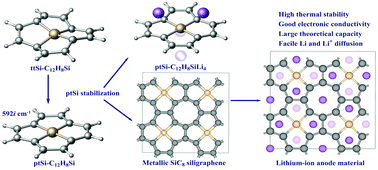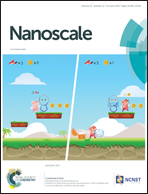Stabilization of planar tetra-coordinate silicon in a 2D-layered extended system and design of a high-capacity anode material for Li-ion batteries†
Abstract
Stabilization of planar tetra-coordinate silicon (ptSi) was achieved in compounds and 2D-layered extended systems, in which single molecular ptSi in C12H8Si captures four additional electrons to maintain a stable planar structure while the extending conjugate interactions are responsible for the stabilization of ptSi in the 2D sheet. Based on the ptSi SiC12 building block, a SiC8 siligraphene 2D sheet was constructed, and each of its ptSi could accommodate six lithium atoms. The electronic and lithium-storage properties of the ptSi 2D network were explored using first-principles calculations and ab initio molecular dynamics (AIMD) simulations. The newly designed 2D SiC8 sheet has high thermal and dynamic stability, good electronic conductivity, strong lithium-storage ability, a large theoretical capacity of 1297 mA h g−1, and facile surface diffusion of Li and Li+. The predicted relatively high average cell voltages from 2.24 to 2.47 V are fairly stable as the lithium content varies. These unique properties of the 2D SiC8 sheet with ptSi make it quite appealing as a novel anode material for high-performance Li-ion batteries (LIBs).

- This article is part of the themed collection: Editor’s Choice: 2D Materials for Energy Storage and Conversion


 Please wait while we load your content...
Please wait while we load your content...